The currency markets are being driven by talk of default.
In Europe, the expectation of a default by Greece, and a bondholder haircut of 50 percent or more, is priced into the market. There’s concern that Italy - a much larger country with a debt level that rivals that of Greece - will be unable to withstand the pressures of another European recession. The cost of a bailout for Italy would be huge. All of those concerns are driving capital out of the euro.
The U.S., struggling with a high level of debt, a slow economy, and political gridlock, is an unlikely magnet for capital flows. But the U.S. has more time to address its fiscal problems, and its economic outlook appears to be a bit stronger than that of Europe. There are few, if any, alternative safe havens for investors. The gold rally appears to have stalled and currencies such as the Japanese yen, the Swiss franc and the Australian and New Zealand dollars all face challenges of their own. Thus, for the time being, the dollar remains the safe haven of choice - a safe haven of and by default.
Institutional Investor contributing writer Steve Rosenbush spoke with three currency strategists - Greg Michalowski, chief currency analyst with foreign-exchange trading platform FXDD; Giulio Martini, chief investment officer, currency strategies, at Alliance Bernstein; and Alan Ruskin, Global Head of G10 foreign exchange strategy at Deutsche Bank - about the dollar’s near-term strength. Here are edited highlights of their conversations.
Institutional Investor: How is the sovereign debt crisis in Europe shaping the outlook for the euro?
Greg Michalowski: The situation in Greece is coming to a head. It looks like the EU is buying some time with a three-step process, recapitalizing European banks so that they can withstand the losses of a Greek default and a haircut of as much as 50 percent. The third stage is economic recovery--and the big question in the market is whether that third step is possible.
Slovakia is voting today on plans for a Greek bailout--the last of 17 countries to vote. Then, the Troika will provide the next tranche of Greek’s bailout. Once that is in place there will be a discussion of whether the European Financial Stability Fund is big enough to fund a bailout.
Overall, there is still a lot of uncertainty in Europe and a lot to do. All of these questions--and the possibility of another European recession--make the euro more vulnerable to the downside at this moment.
It is one thing to say something, another thing to do it. The IMF and Europe have talked about a bailout plan, tied to the privatization of Greek pubic assets. Well, privatization isn’t easy. Who is going to buy them now, at the bottom of the market. How will they be valued? The IMF and the EU can promise debt relief to Greece, and Greece can promise privatizations, but they don’t seem to be getting anywhere. The problem is ongoing, and it’s immense. It will take longer than expected to put it in place, and it will take longer than expected to determine whether it has been successful.
Germany, France and northern European countries are reluctant to pour more money into a bailout fund for Greece and possibly other countries. An alternative is to leverage the EFSF in the private market. Is that a workable solution?
The solution seems to be to use private money and leverage to safe public cash. There has been talk of China coming in, and talk of Warren Buffett coming in, just as he did in the U.S. In the case of the U.S., this approach worked, and the banks eventually paid of their debt. But the approach may be more difficult in Europe because the EU isn’t a full fiscal union. In think that getting private investors to a piece of the European bailout may be riskier in the European situation.
Given the situation, what is your forecast for the euro?
I would be positioned long on the dollar at this point. The euro moved from a high of 145.48 at the end of August to a low of 131.44 on October 4. It has rallied since then to 136.97 on October 10. I think that was the peak. I am looking now for a downward move to the 132.50 area, with stops if it moves above the 136.80 to 137 level.
If the global economy is going to slow down, commodity driven economies such as Australia and New Zealand are vulnerable to the downside. If there is a risk-off trade, they may come under pressure. I see resistance in New Zealand at the 80 level. It is now 78.
And countries such as Australia, which have raised rates, may lower rates if the economy slows.
The Japanese yen has become a very stable currency and remains a safe haven, but the weak economy tugs at it. If the yen moves too high, the Bank of Japan would be prepared to act, for obvious reasons. If I was going to buy the yen, it would be on a break against the dollar at the 77 level. What would be a trading idea.
Overall, it’s a very difficult time in the markets.
II: How is the European sovereign debt crisis weighing on the euro?
Giulio Martini: In terms of the dollar and the euro, it’s a choice of two currencies with poor fundamentals. For most of the post-2009 recovery period, the euro was a bit stronger, because the ECB was less aggressive than the Fed when it came to stimulating the economy. But for now, I would favor the dollar.
Just imagine if 17 U.S. states, as diverse as Mississippi and Massachusetts, had to come to an agreement, in unison, about bailing out another state. What are the odds of that happening? Almost zero. That is what has to happen in Europe. It is not a very smooth or calm decision making process, and it is working against the value of the euro.
But what is really driving the market is a fear that Italy is in play. Greece accounts for less than 2 percent of European GDP. Italy accounts for 17 percent, and it is one of the most highly indebted countries in the world.
In their book This Time It’s Different, Carmen Reinhardt and Kenneth Rogoff argue that countries have a hard time maintaining growth when public debt exceeds 90 percent of GDP. In Greece, that ratio is now 142 percent. But in Italy, the ratio is 119 percent. There’s a fear that if Europe goes into another recession, that Italy won’t be solvent. That is really what is driving the markets now. And a bailout of Italy would make the bailout of Greece look like a picnic.
One solution is to use private money to leverage the EFSF. But that use of debt has drawn comparisons to CDOs, financial instruments at the heart of the credit crisis in 2008 and 2009. Is that comparison valid?
Ultimately, using private money to leverage the EFSF is a pretty decent idea. Relying solely on public funds would throw the credit rating of Germany and other countries into question. Public debt, as a percentage of GDP, already has reached 80 percent in Germany and France. Its not as risky as a CDO squared or a CDO cubed.
What are your biggest overweights?
We are long the yen and very slightly long the dollar. Those are are our biggest overweights right now, followed by the Norwegian and Swedish krona and the New Zealand dollar. We are neutral on the pound. We are short the euro and the Canadian dollar--those are the two most sizable shorts that we have.
How is the European sovereign debt crisis weighing on the euro?
Alan Ruskin: The currency markets are all highly correlated with the news. As soon as you have a bad headline, the dollar and the yen are the only beneficiaries. The markets aren’t responding to to anything that might be a traditional interest rate story. For example, if the U.S. has a stronger than expected employment report, that is taken as a risk-on signal and the dollar tends to fall. All the currencies are very much correlated with risk indicators.
It really depends upon your time horizon, and where you believe Europe is going. If you believe that a credible package for Greece will be put forward in early November, you can be long risk and maybe even long the euro. If you believe the market will go though another period of second guessing the package, then you take a different sort of view on the euro.
I think a plan for Greece will be forthcoming. My concern is that it is a starting point. Whatever the decision on Greece, it has got to have a negative side to it. There are no free lunches here. If the plan demands greater participation by the private sector, it means a larger haircut for investors. Greek banks will need to be recapitalized, and other banks will need capital, too.
There is some talk of going back to the original plan, with a 21 percent haircut, which France supports. But that will be seen as kicking the can down the road. It won’t be cathartic.
In my view, there will be hiccups, without question.
How do you expect the euro to trade?
I think the market will give the central bankers the benefit of the doubt at first, but I see the euro going lower, to 125, by the middle of next year. It still isn’t weak at that level. We don’t forecast it to go even lower because the U.S. has its own problems. The tail risk is that huge policy errors are made during the next few months.
How do you expect other currencies to trade?
In a soft landing scenario, we could see the Australian dollar do quite well. Brazil, Mexico, and other emerging markets could come back.
In a hard landing scenario, only the U.S. dollar and the yen stand up. The yen is the only currency that will do well in a hard or soft landing. Part of it is just a matter of finding liquidity in a market that is less exposed to Europe. Norway and Sweden are very different - Sweden is more cyclical, with growth oriented companies and it is more tied to the global cycle. Norway is more commodity influenced. But both countries have excellent fundamentals and should at least hold their own over a two to five year time frame.






